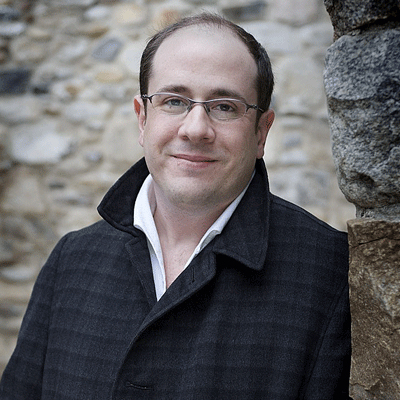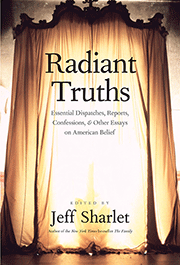Jeff Sharlet on Radiant Truths
Jeff Sharlet on his collection of essential dispatches, reports, confessions, and other essays on American belief
 Jeff Sharlet is a contributing editor of Harper’s Magazine, a founding editor of the online journals Killing the Buddha and The Revealer, and the author of such nonfiction books as C Street, The Family, and Sweet Heaven When I Die. This year, he has assembled twenty-four of his favorite “dispatches, reports, confessions, and other essays” about American religion in a collection called Radiant Truths (Yale University Press). The book traces the history of faith in the United States, starting at the deathbed of a Civil War soldier and ending at Zuccotti Park during the Occupy Wall Street protests. These are on-the-ground reports by journalists grappling with faith and doubt in their own days, and they include works by James Baldwin, Zora Neale Hurston, Mark Twain, Walt Whitman, and many others. The resulting collection isn’t simply a book about religion — it’s also about our attempts to write about the unknown, to capture the transcendent on paper. I put six questions to Sharlet about the book:
Jeff Sharlet is a contributing editor of Harper’s Magazine, a founding editor of the online journals Killing the Buddha and The Revealer, and the author of such nonfiction books as C Street, The Family, and Sweet Heaven When I Die. This year, he has assembled twenty-four of his favorite “dispatches, reports, confessions, and other essays” about American religion in a collection called Radiant Truths (Yale University Press). The book traces the history of faith in the United States, starting at the deathbed of a Civil War soldier and ending at Zuccotti Park during the Occupy Wall Street protests. These are on-the-ground reports by journalists grappling with faith and doubt in their own days, and they include works by James Baldwin, Zora Neale Hurston, Mark Twain, Walt Whitman, and many others. The resulting collection isn’t simply a book about religion — it’s also about our attempts to write about the unknown, to capture the transcendent on paper. I put six questions to Sharlet about the book:
1. You’ve helped found two online journals, authored four books, and edited another two, all dedicated to faith and religion. What draws you to the subject?
I’m drawn to religion as a subject for much the same reason I’m drawn to documentary art. What excites me most in writing — what seems to me most vital, closest to life — is the tension between the evidence and our arrangement of the evidence. Facts and interpretation. “Real toads” and “imaginary gardens.” Perception and belief. Writing about religion means always, to some extent, reaching beyond the stack of facts. The who-what-where-when-why is not enough if you’re trying to describe the intangible and its relationship to the material. So you have to find ways to document “the evidence of things not seen,” as the apostle Paul put it in a different context. You have to engage with art as well as fact. You have to acknowledge your own subjectivity. You have to tell a story.
Radiant Truths features several stories from the archives of Harper’s Magazine. Please read Jeff Sharlet’s introductions to Sara Jeannette Duncan’s “The Ordination of Asoka” (1903) and Mary McCarthy’s “Artists in Uniform” (1953), then read Duncan’s and McCarthy’s stories.
2. Every piece collected here touches on transcendence, but not all are explicitly religious. Reading, I was reminded of friends who say “I’m spiritual, not religious.” You’ve written elsewhere that you’re averse to the word “spiritual,” in the sense that you don’t like seeing your books filed in the Spirituality section of libraries and bookstores. Why is that?
Because I’m a curmudgeon. Here’s this word that millions of people find lovely and liberating — an alternative to all that seems calcified about religion, and what do I do? I complain. I think that in nine out of ten cases “spirituality” is a con — not a con by the person invoking it, but a con on that person. It offers the illusion of individual choice, as if our beliefs, or our rejection of belief, could be formed in some pure Ayn Randian void. For better and worse we make our beliefs and live our beliefs together. That’s what you get with the word “religion,” which means to tie, to bind. You may not want to be bound! I don’t. But we are. We’re caught up in a great, complicated web of belief and ritual and custom. That’s what I’m interested in, not the delusion that I’m some kind of island.
3. You call these pieces “dispatches, reports, confessions, and essays” and spend time in your introduction further breaking down the categories, assessing terms like “creative nonfiction,” “narrative nonfiction,” and “new journalism.” You consider “essay” in the originary sense of the French verb for “to attempt,” and “documentary” as the “creative treatment of reality.” Ultimately, you settle on “literary journalism.” What makes this the best fit?
Notice that almost all the names are mash-ups. (My first Harper’s editor, Bill Wasik, preferred the term “reported essay.” Then again, he also coined “submersion journalism.”) It’s as if the genre’s ambitions, its project, can’t be summed up in just one word. Which I think is true — every one of these labels contains a contradiction. I use literary journalism because it puts that contradiction in the starkest terms. You might read it as “literary vs. journalism.” Or art vs. fact. The genre’s on the tightrope in between.
Of course, you need to remember that “literary” is not an endorsement, not a declaration of quality. There’s a lot more bad literature in the world than good. What it invokes is a tradition, a history of the forms we use to tell stories or write poems. Journalism, on the other hand, is at its root unconcerned with tradition. Journalism is impertinent; it supposes that we have the right to ask any questions we please about the world around us. If literature is aristocratic, journalism is democratic. Now tie their legs together and watch ’em run. That lurching movement toward the real is the awkward revelation of a hybrid, mutant genre.
4. In “The Devil Baby at Hull House,” Jane Addams’s 1916 essay about the tenements of working-class Chicago, she writes that the role of literature is to “translate the particular act into something of the universal.” For authors in this collection, the act of reporting, of recording true events, is itself transcendent. Is journalism — that struggle to translate the particular into the universal, or make the universal particular — a spiritual act?
In a sense, I think I might prefer the word “religious” here. It’s a broader term, one that doesn’t require belief. Religion often includes belief, but not always. It’s embedded in ritual, in language, in custom, in practice. When people ask me if I’m a religious person — and when you write about religion, people always do — I dodge the question by saying that the act of writing about religion is my practice. “Practice” can refer to religious behavior, but I like its more colloquial meaning. I’m practicing journalism, practicing perception. I think we need to practice perception all the time, or we’ll fall prey to some very bad religion — the unconsidered, received wisdom of things-as-they-are. I like your particular/universal, universal/particular set-up, because it reminds me of a metaphor I borrow from Wendy Doniger, a great historian of religion: that of the telescope and the microscope. The telescope gives us that “universal” vision; the microscope gives us the particular. The most powerful stories — the journalism I believe in — attempt to do both.
5. In Zora Neale Hurston’s 1935 piece about Voodoo, she writes of the importance of “seeing in more ways than one.” When it comes to faith in America, why do we need to hear a range of voices, and is this what you mean when you use the phrase “a democracy of stories” in your introduction?
For me, this goes back to my first book, Killing the Buddha, which was in part a travelogue I wrote with my friend Peter Manseau — a tour of some of the varieties of religious experience in America. When we published the book, the most common question we received — weirdly, from other journalists, hosts of radio shows, and so on — was along the lines of, “What’s the great common denominator of American belief?” To which we could only say, “Oy.” Because America, at its most interesting, is not a real “great common denominator” kind of place. We’re not singing in harmony. Rather, the sound of belief in America — “the noise of democracy,” as President James Buchanan put it in in his only memorable phrase — is cacophony, countless voices singing different songs together. Which is kind of wonderful.
 6. The final piece in this collection is a brief dispatch from Occupy Wall Street. What is the place of protest in the American story?
6. The final piece in this collection is a brief dispatch from Occupy Wall Street. What is the place of protest in the American story?
American democracy, inasmuch as it’s real and not just a story, has a grand old tradition of protest. You might call it our literature and our journalism, both at once. The book begins and ends with a writer who thought so: Walt Whitman, a writer for whom joyous affirmation could be as much of a protest as negation. I start with some passages from Specimen Days, Whitman trying to document the particulars of dying soldiers during the Civil War and, at the same time, the particulars of his love for the dream of democracy — “full of reality, full of illusion,” as he puts it. I end with this dispatch from 2011’s Occupy Wall Street movement, in which Francine Prose goes down to Zuccotti Park to see what it’s all about, carrying with her these deep anxieties about democracy and its opposite, the stories that bind us, and then she sees a placard with a line from Whitman’s “Song of Myself” “I am large, I contain multitudes.” And since Radiant Truths is an anthology — which means that despite all my attempts to direct the reader, first this story, then that one, you’ll probably find your own crooked path through it — I think it’s fair to reveal the last line: “And that was when I just lost it and stood there and wept.” But a good kind of crying, you know? The best kind.


